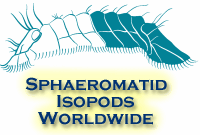| Abstract |
Samples were taken during the expeditions ANDEEP I & II (ANT XIX/3-4) (ANtarctic benthic DEEP-sea biodiversity, colonisation history and recent community patterns) with RV Polarstern for the analysis of the Southern Ocean (SO) deep-sea isopod biodiversity in the Drake Passage, off Elephant Island, along the South Shetland Islands, in the northwestern Weddell Sea, and at the South Sandwich Islands. In total 5525 specimens of Isopoda were sampled and 317 species were discriminated. Isopoda were the most abundant peracarid taxon, with 38% of all Peracarida, 98% of the Isopoda belonging to the suborder Asellota. Species richness was highest in the northwestern Weddell Sea; diversity and evenness were relatively high at all stations. The Munnopsididae were the most dominant isopod family, with 61% of the specimens, 118 species divided among 28 genera; the Haploniscidae comprised 15% of all isopods with 36 species from four genera, followed by the Ischnomesidae with 7% and 30 species from five genera. The families Desmosomatidae, Macrostylidae and Nannoniscidae comprised 10% of the isopod specimens. The Desmosomatidae were the second most diverse family, with 48 species from 12 genera. Species of the suborder Valvifera or the family Serolidae were much rarer in the SO deep-sea than on the shelf. 141 of isopod species (46% of the total number) were rare, occurring only at one of the 21 epibenthic-sledge stations. A cluster analysis showed no clear relation between isopod communities and geographic area. Depth was the most important factor for differences in isopod community patterns. The species accumulation curve shows that the SO deep sea was not sampled representatively during ANDEEP I & II and further sampling is necessary. The SO deep-sea differs in faunal composition from the shelf. |

















